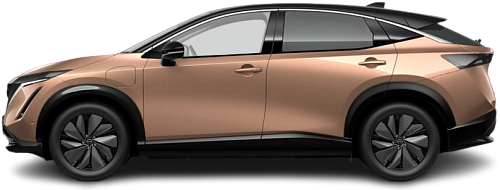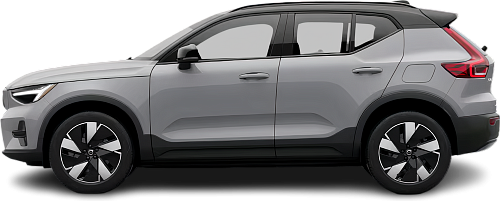Global EV Comparison: Nissan Ariya 87 kWh FWD vs Volvo XC40 Recharge (EX40) Pure Electric
Struggling to Decide? Let AI Help!
Your AI Summary Is Ready!
General Info
The Nissan Ariya 87 kWh FWD (2021-…) is currently produced, it has a starting price of €53490. The Volvo XC40 Recharge (EX40) Pure Electric (2022) has been discontinued. You can find it for as low as €30890 on the used car market.
The two vehicles share the same body style: SUV.
| Property | Nissan Ariya 87 kWh FWD | Volvo XC40 Recharge (EX40) Pure Electric |
|---|---|---|
| Years of Production | 2021-… | 2022-2022 |
| Current Status | Produced | Discontinued |
| Country of Manufacture | Japan, China | Belgium |
| Body Style | SUV | SUV |
| Market Availability | EU, USA | EU |
| Price Europe (New) | €53490 | - Price Europe (New) |
| Price Europe (Used) | €39898 | €30890 |
| GCC Score | 6.4 | 6.1 |
Range and Efficiency
While the Nissan Ariya 87 kWh FWD (2021-…) offers a longer real-world range and a bigger battery, it is less energy-efficient than the Volvo XC40 Recharge (EX40) Pure Electric (2022).
| Property | Nissan Ariya 87 kWh FWD | Volvo XC40 Recharge (EX40) Pure Electric |
|---|---|---|
| Range (EPA) | 489 km | - Range (EPA) |
| Range (WLTP) | 536 km | 425 km |
| Range (GCC) | 462 km | 366 km |
| Battery Capacity (Nominal) | 91 kWh | 69 kWh |
| Battery Capacity (Usable) | 87 kWh | 67 kWh |
| Efficiency per 100 km | 18.8 kWh/100 km | 18.3 kWh/100 km |
| Efficiency per kWh | 5.31 km/kWh | 5.46 km/kWh |
| Range and Efficiency Score | 7.3 | 6.2 |
Charging
Both vehicles utilize a standard 400-volt architecture.
The Volvo XC40 Recharge (EX40) Pure Electric (2022) offers faster charging speeds at DC stations, reaching up to 150 kW, while the Nissan Ariya 87 kWh FWD (2021-…) maxes out at 130 kW.
The Nissan Ariya 87 kWh FWD (2021-…) features a more powerful on-board charger, supporting a maximum AC charging power of 22 kW, whereas the Volvo XC40 Recharge (EX40) Pure Electric (2022) is limited to 11 kW.
| Property | Nissan Ariya 87 kWh FWD | Volvo XC40 Recharge (EX40) Pure Electric |
|---|---|---|
| Max Charging Power (AC) | 22 kW | 11 kW |
| Max Charging Power (DC) | 130 kW | 150 kW |
| Architecture | 400 V | 400 V |
| Charge Port | CCS Type 2 | CCS Type 2 |
| Charging Score | 6.5 | 6.1 |
Performance
Both vehicles are front-wheel drive.
Although the Nissan Ariya 87 kWh FWD (2021-…) has more power, the Volvo XC40 Recharge (EX40) Pure Electric (2022) achieves a faster 0-100 km/h time.
| Property | Nissan Ariya 87 kWh FWD | Volvo XC40 Recharge (EX40) Pure Electric |
|---|---|---|
| Drive Type | FWD | FWD |
| Motor Type | EESM | PMSM |
| Motor Power (kW) | 178 kW | 170 kW |
| Motor Power (hp) | 239 hp | 228 hp |
| Motor Torque | 300 Nm | 330 Nm |
| 0-100 km/h | 7.6 s | 7.4 s |
| Top Speed | 160 km/h | 160 km/h |
| Performance Score | 3.6 | 3.6 |
Dimensions
The Nissan Ariya 87 kWh FWD (2021-…) is longer, but has a similar width and height to the Volvo XC40 Recharge (EX40) Pure Electric (2022).
The Nissan Ariya 87 kWh FWD (2021-…) boasts a more extended wheelbase.
| Property | Nissan Ariya 87 kWh FWD | Volvo XC40 Recharge (EX40) Pure Electric |
|---|---|---|
| Length | 4595 mm | 4425 mm |
| Width (with Mirrors) | 2172 mm | 2034 mm |
| Width (w/o Mirrors) | 1850 mm | 1873 mm |
| Height | 1660 mm | 1652 mm |
| Wheelbase | 2775 mm | 2702 mm |
Cargo and Towing
The Nissan Ariya 87 kWh FWD (2021-…) provides more cargo capacity, featuring both a larger trunk and more space with the rear seats folded.
A frunk (front trunk) is available in the Volvo XC40 Recharge (EX40) Pure Electric (2022), but the Nissan Ariya 87 kWh FWD (2021-…) doesn’t have one.
The Volvo XC40 Recharge (EX40) Pure Electric (2022) is better suited for heavy loads, offering a greater towing capacity than the Nissan Ariya 87 kWh FWD (2021-…).
| Property | Nissan Ariya 87 kWh FWD | Volvo XC40 Recharge (EX40) Pure Electric |
|---|---|---|
| Number of Seats | 5 | 5 |
| Curb Weight | 2121 kg | 2030 kg |
| Cargo Volume (Trunk) | 466 l | 410 l |
| Cargo Volume (Max) | 1350 l | 1295 l |
| Cargo Volume (Frunk) | - Cargo Volume (Frunk) | 31 l |
| Towing Capacity | 750 kg | 1500 kg |
| Cargo and Towing Score | 6.8 | 6.7 |




